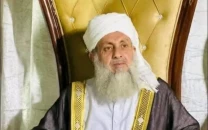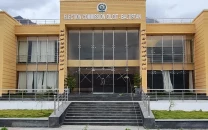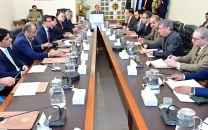PML-N claims credit for sectarian harmony in G-B
Different religious groups say Awami Action Committee played bigger role

PHOTO: PPI
The Pakistan Muslim League-Nawaz (PML-N)-led G-B government claims credit for having restored peace in the mountainous regions despite the presence of dissenting voices, which say the credit for this calm lies elsewhere.
Muharram security: G-B govt to suspend traffic on KKH for Ashura
“You can see sectarian tension has disappeared from the region since we took over the reins of the G-B’s government in June 2015,” said Ibrahim Sanai, the minister for education in the PML-N-led government. “I think that’s our biggest achievement.” he told The Express Tribune.
The minister’s comments referred to the sectarian crisis which had peaked during the five years, when the Pakistan Peoples Party’s (PPP) was at the helm in the G-B. Attacks on passenger buses along the Karakoram Highway (KKH) in 2011-12 had left around 100 people dead.
“Peace has returned to the entire region and now development is taking place,” he claimed.
Indeed, a period of calm has coincided with the ascendency of the PML-N in power corridors of both Islamabad and Gilgit. It has also coincided with a nationwide sweep for criminals and terrorists under the National Action Plan (NAP), implemented after the December 2014 massacre of around 140 students and staff at the Army Public School in Peshawar.
According to the statistics provided by the police, over 400 people have been arrested in the region in the past year alone. “Of these 60 were involved in heinous crimes and fell in the category of proclaimed offenders,” read an official document.
Ashura message: President, PM call for forging unity
Additionally, police also recovered huge caches of weapons during different raids in Gilgit and in other parts of the region. However, the role of Awami Action Committee (AAC) – an alliance of various religious and political groups of the region – can also not be overlooked.
“Credit for the peace goes to the AAC,” said the AAC’s former chief Sultan Raees.
“The government is perhaps referring to the imposition of schedule-IV under which various individuals are put under observation. But that has backfired,” he added. Raees, who recently resigned from the Ahle Sunnat Wal Jamaat (ASWJ) of which he was the spokesman.
Several firebrand clerics of the ASWJ were recently barred from entering the region ahead of Muharram.
Heavy security: Ashura processions culminated peacefully in Hazara
Ilyas Siddiqi, a spokesman for Majlis Wahdatul Muslimeen, also voiced scepticism over any role the PML-N government in restoring peace in the region. “We all know it was AAC which helped restore peace,” he said, echoing Raees.
The AAC rose to prominence during the 2014 strikes over withdrawal of the wheat subsidy for the region. Realising its new found influence, the AAC extended itself to address the sectarian conflict in the region by convincing clerics of both sects to maintain peace.
Published in The Express Tribune, October 30th, 2016.


















COMMENTS
Comments are moderated and generally will be posted if they are on-topic and not abusive.
For more information, please see our Comments FAQ